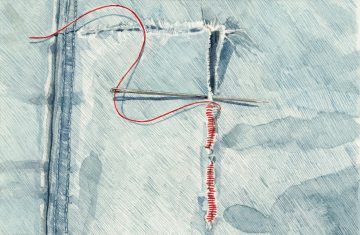Benjamin Leszcz in The Globe and Mail:
 Several years ago, while living in London, England, my wife met Prince Charles at an event associated with the Prince’s Foundation, where she worked. She returned with two observations: First, the Prince of Wales used two fingers – index and middle – when he pointed. Second, Charles’s suit had visible signs of mending. A Google search fails to substantiate the double-barrelled gesture, but the Prince’s penchant for patching has been well documented. Last year, the journalist Marion Hume discovered a cardboard box containing more than 30 years of off-cuts and leftover materials from the Prince’s suits, tucked away in a corner at his Savile Row tailor, Anderson & Sheppard. “I have always believed in trying to keep as many of my clothes and shoes going for as long as possible … through patches and repairs,” he told Ms. Hume. “In this way, I tend to be in fashion once every 25 years.”
Several years ago, while living in London, England, my wife met Prince Charles at an event associated with the Prince’s Foundation, where she worked. She returned with two observations: First, the Prince of Wales used two fingers – index and middle – when he pointed. Second, Charles’s suit had visible signs of mending. A Google search fails to substantiate the double-barrelled gesture, but the Prince’s penchant for patching has been well documented. Last year, the journalist Marion Hume discovered a cardboard box containing more than 30 years of off-cuts and leftover materials from the Prince’s suits, tucked away in a corner at his Savile Row tailor, Anderson & Sheppard. “I have always believed in trying to keep as many of my clothes and shoes going for as long as possible … through patches and repairs,” he told Ms. Hume. “In this way, I tend to be in fashion once every 25 years.”
As it happens, double-breasted suits are rather on-trend. But more notable is Charles’s sartorial philosophy, which could not be timelier. The Prince comes from a tradition of admirable frugality – the Queen reuses gift-wrap – but his inclination to repair rather than replace, to wear his clothes until they wear out, is an apt antidote to our increasingly disposable times. Most modern consumers are not nearly so resourceful: The average Canadian buys 70 new pieces of clothing each year, about 60 of which ultimately wind up in a landfill.
More here.
